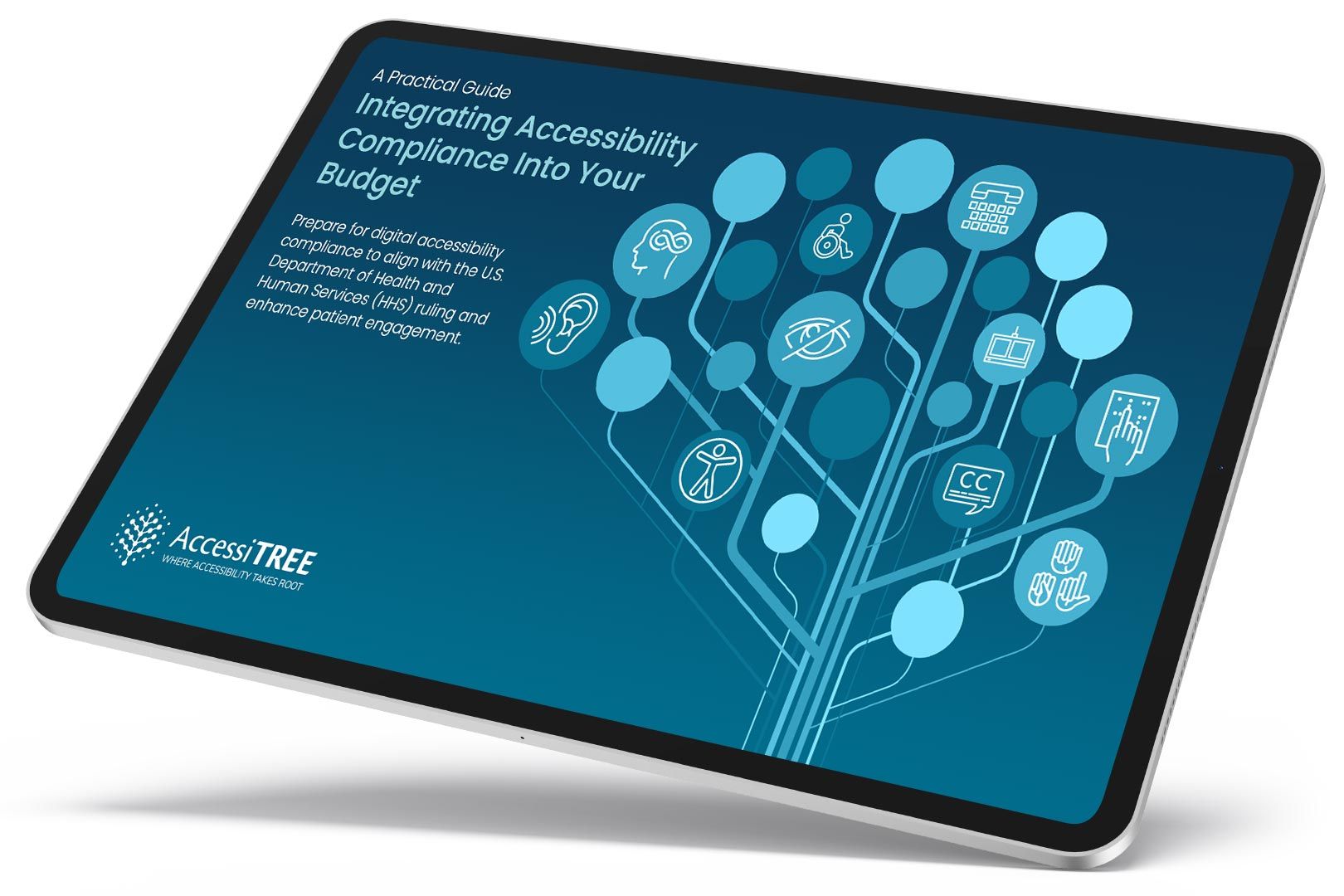
Why Widget-Based Accessibility Solutions Are Failing Healthcare Organizations
At first glance, widget-based accessibility solutions seem like an oasis in the desert of digital inaccessibility—promising quick fixes, minimal effort, and instant compliance. But, like a mirage, these solutions fade upon closer inspection, leaving organizations stranded with unresolved issues. Far from providing meaningful accessibility improvements, these tools often mask deeper problems, create new barriers, and increase legal and reputational risks.
This article explores why widget-based accessibility solutions are inadequate, citing evidence and expert opinions, and presents the only sustainable path forward: true remediation.
Shortcuts Are Not the Answer
Accessibility widgets are marketed as one-size-fits-all solutions that overlay accessibility features onto existing websites. While they may initially seem like a time-saving and budget-friendly option, they fail to address the root causes of inaccessibility. Here are several reasons why shortcuts like these are inherently flawed:
- Lack of Comprehensive Coverage: Widgets claim to fix accessibility issues by adding features like screen reader compatibility, keyboard navigation, and color contrast adjustments. However, they can only address a small subset of Web Content Accessibility Guidelines (WCAG) requirements. Complex issues, such as improper HTML structure or inaccessible forms, remain unaddressed.
- Poor User Experience: Users with disabilities often find these tools frustrating and ineffective. Studies have shown that overlays introduce new barriers instead of removing existing ones. For example, keyboard users may encounter focus traps or inconsistent navigation, making the site even harder to use.
- Non-Comprehensive Testing: Accessibility widgets rely on automated fixes and scanning tools that miss over 70% of accessibility issues, according to a 2021 WebAIM report. Without thorough manual testing by accessibility experts, true inclusivity cannot be achieved.
- Dependence on External Scripts: These solutions rely on third-party scripts that can slow down website performance and even break entirely if the script is disabled or the provider discontinues service.
Legal Risks: Accessibility Widgets Are Not a Shield
Healthcare organizations are not only risking poor user experiences but also exposing themselves to significant legal vulnerabilities when they rely on accessibility overlays alone. Courts across the United States have increasingly ruled that these third-party widgets are insufficient for achieving ADA compliance, and in many cases, they have served as evidence of non-compliance rather than a defense.
Landmark Cases Demonstrating the Risks
- Domino’s Pizza v. Robles (2019): This case underscored that websites and mobile apps must be accessible under the Americans with Disabilities Act (ADA). Critically, the court found that companies cannot simply outsource compliance to third-party overlay tools and assume legal immunity.
- Krispy Kreme (2022): The company faced a lawsuit for relying on accessibility overlays, which failed to provide meaningful accommodations for blind users. Plaintiffs argued that these widgets masked underlying accessibility issues rather than addressing the root causes, contributing to an ineffective user experience.
Plaintiff Attorneys Target Overlays
Lawyers representing individuals with disabilities are increasingly scrutinizing healthcare organizations—and other businesses—that depend on overlay widgets. Because these tools often do little to resolve fundamental barriers to digital access, their mere presence can become proof of a lack of genuine compliance efforts. Lawsuits and demand letters frequently highlight the continued obstacles that overlays fail to remove, ranging from inaccessible forms to unlabeled images and menus.
Regulatory Trends
Regulatory bodies have reinforced that overlays alone are insufficient:
- Department of Justice (DOJ): Through enforcement actions and statements, the DOJ has clarified that organizations must meet ADA standards by ensuring true digital accessibility for all users. Merely embedding an accessibility widget or overlay is not an acceptable alternative to addressing the underlying issues.
- HHS Ruling: Recent guidance from the Department of Health and Human Services further emphasizes the importance of comprehensive digital accessibility. This is particularly critical in healthcare, where online resources and portals serve vital patient needs.
For healthcare providers, the takeaway is clear: accessibility overlays are not a legally defensible shortcut. Instead, a holistic approach—remediating code, providing consistent alternative text, ensuring proper color contrast, and following best practices for accessibility—remains the most reliable path to compliance and user satisfaction.
True Remediation: The Sustainable Solution
The only reliable way to achieve accessibility is through true remediation—addressing accessibility at the code and design level. Here is how healthcare organizations can build an inclusive and compliant digital experience:
- Comprehensive Audits: Begin with a thorough audit conducted by certified accessibility professionals. These audits go beyond automated scans to include manual testing by users with disabilities.
- Addressing Foundational Issues: Remediation involves correcting inaccessible code, ensuring proper semantic HTML, and optimizing user interfaces for all assistive technologies. For example:
- Forms should have properly labeled fields.
- Images must include descriptive alt text.
- Videos require accurate captions and transcripts.
- Ongoing Accessibility Maintenance: Accessibility is not a one-and-done project. Organizations must continuously test, monitor, and update their digital assets to maintain compliance as technologies evolve.
- Training and Education: Internal teams should receive accessibility training to integrate best practices into all stages of digital development. This creates a culture of inclusion and prevents future accessibility barriers.
The Cost of Inaction
For healthcare organizations, the stakes are especially high. Patients with disabilities rely on accessible digital experiences to book appointments, access medical records, and communicate with providers. When these needs are unmet, the consequences can be dire—both for the patient and the organization.
- Patient Trust: A poorly accessible website can erode trust and deter patients from seeking care. This is particularly harmful in an industry where trust is paramount.
- Reputational Damage: Negative publicity stemming from lawsuits or user complaints can tarnish an organization’s reputation, making it harder to attract and retain patients.
- Financial Penalties: Non-compliance can result in costly lawsuits, settlements, and government fines. The investment in true remediation pales in comparison to the potential financial fallout of inaction.
Widget-based accessibility solutions are a dangerous shortcut that healthcare organizations cannot afford to take. While they promise quick fixes, they deliver incomplete solutions, alienate users, and invite legal scrutiny. The only path to meaningful accessibility is true remediation—a process that addresses the root causes of inaccessibility and ensures compliance with established standards like WCAG 2.1 and 2.2.
AccessiTREE provides the real solution healthcare organizations need. Offering both self-service and full-service remediation solutions, AccessiTREE empowers organizations to achieve compliance effectively and efficiently. By addressing foundational issues, conducting comprehensive audits, and providing ongoing support, AccessiTREE ensures that digital accessibility becomes a seamless and sustainable part of your operations.
By investing in comprehensive audits, foundational fixes, and ongoing maintenance, healthcare organizations can not only meet legal requirements but also foster a truly inclusive digital environment. The choice is clear: shortcuts lead to failure, while true remediation paves the way for lasting success.
Sources
- WebAIM, “The WebAIM Million Report,” 2021. https://webaim.org/projects/million/
- U.S. Department of Justice, “Guidance on Web Accessibility and the ADA,” 2022. https://www.ada.gov/resources/web-guidance/
- ADA Title III Lawsuit Tracker, 2024. https://www.adatitleiii.com/2025/03/ada-title-iii-federal-lawsuit-numbers-rebound-to-8800-in-2024/
- W3C, “Web Content Accessibility Guidelines (WCAG) 2.2,” 2023. https://www.w3.org/TR/WCAG22/

